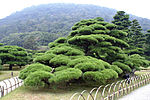Ritsurin Garden
| Ritsurin Kōen | |
|---|---|
| Ritsurin Garden (栗林公園) | |
 | |
 | |
| Type | Japanese garden |
| Location | Takamatsu, Japan |
| Coordinates | 34°19′47″N 134°02′38″E / 34.329591°N 134.043968°E |
| Area | 75 ha |
| Created | 1625 |
| Ritsurin Garden | |||||
|---|---|---|---|---|---|
| Japanese name | |||||
| Kanji | 栗林公園 | ||||
| Hiragana | りつりんこうえん | ||||
| Katakana | リツリンコウエン | ||||
| |||||
Ritsurin Garden (栗林公園, Ritsurin Kōen, lit. chestnut grove garden) is one of the most famous historical gardens in Japan. The garden is situated in the city of Takamatsu and is considered one of its main attractions. The garden contains a tea house, various folk art and craft exhibits (including the Sanuki Folk Craft Museum), as well as various folk art and craft items for sale.
A tour through the garden generally takes one to two hours. There are various bridges, footpaths and small hills which offer a beautiful view of the garden and the surrounding scenery, most notably Mt. Shiun (紫雲山, Shiun-zan) at the western border of the garden.[1]
History
The buildings in the garden date back to the early 17th century. In 1625, the feudal lord of Takamatsu in Sanuki Province, Ikoma Takatoshi (生駒高俊), began construction of Ritsurin, specifically the building of a garden around the South Pond using the beautiful greenery of Mt. Shiun (Purple Cloud Mountain) as a backdrop. Beginning in 1642, Matsudaira Yorishige (松平頼重) took over the area and continued its construction. The work was completed by the Fifth Lord Yoritaka in 1745 after 100 years of improvements and extensions made by the successive lords. After the new Meiji government requisitioned the garden, it was designated a prefectural garden and opened to the public on 16 March 1875. In 1953, the garden was designated a Special Place of Scenic Beauty (日本の特別名勝, Nihon no Tokubetsu Meishō).
Features
The garden covers 750,000 square meters.[2] Among the features of the garden are:
- Kikugetsu-tei (Moon Scooping Pavilion): This teahouse located in the southern section of the garden was built in the early years of the Edo period (around 1640).
- Hakomatsu: Carefully cultivated black pine trees; their branches, twigs, and needles are elaborately trimmed into geometrical shapes and figures.
- Hiraiho
- Fuyō-ho
- Wild Duck Hunting Moat
- Sai-ko (Western Lake)
- Nan-ko (Southern Lake)
The many ponds and streams are full of koi and the pond at the Tea House has benches where visitors may sit and feed the fish from breadsticks purchased at the Tea House.
Gallery
-
Gun_o Pond
-
Mt. Shiun
-
Sai-ko
-
Nan-ko
-
Rock formation
Access
- JR Shikoku: Kōtoku Line, Ritsurin-Kōen-Kitaguchi Station
- Takamatsu-Kotohira Electric Railroad (Kotoden): Ritsurin-Kōen Station
- Kotoden Bus: Ritsurin Kōen Mae stop
- Kōsoku Bus Ritsurin Kōen Mae stop
See also
References
Bibliography
- Mansfield, Stephen (2011). Japan's Master Gardens - Lessons in Space and Environment (Hardback). Tokyo, Rutland, Singapore: Tuttle. ISBN 978-4-8053-1128-8.
External links
- Ritsurin Garden
- Comprehensive Database of Archaeological Site Reports in Japan, Nara National Research Institute for Cultural Properties
- 60252671 Ritsurin Garden on OpenStreetMap















